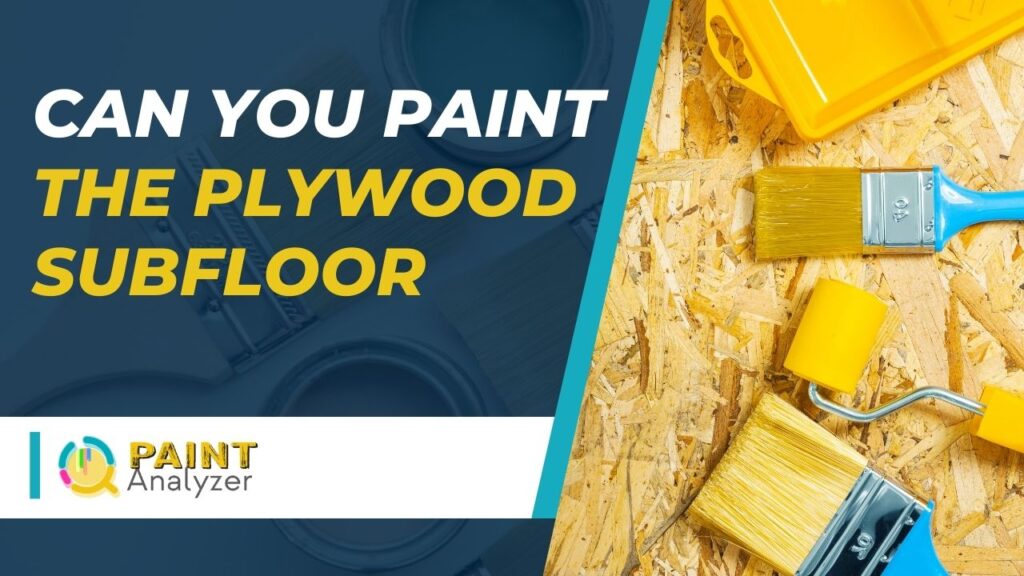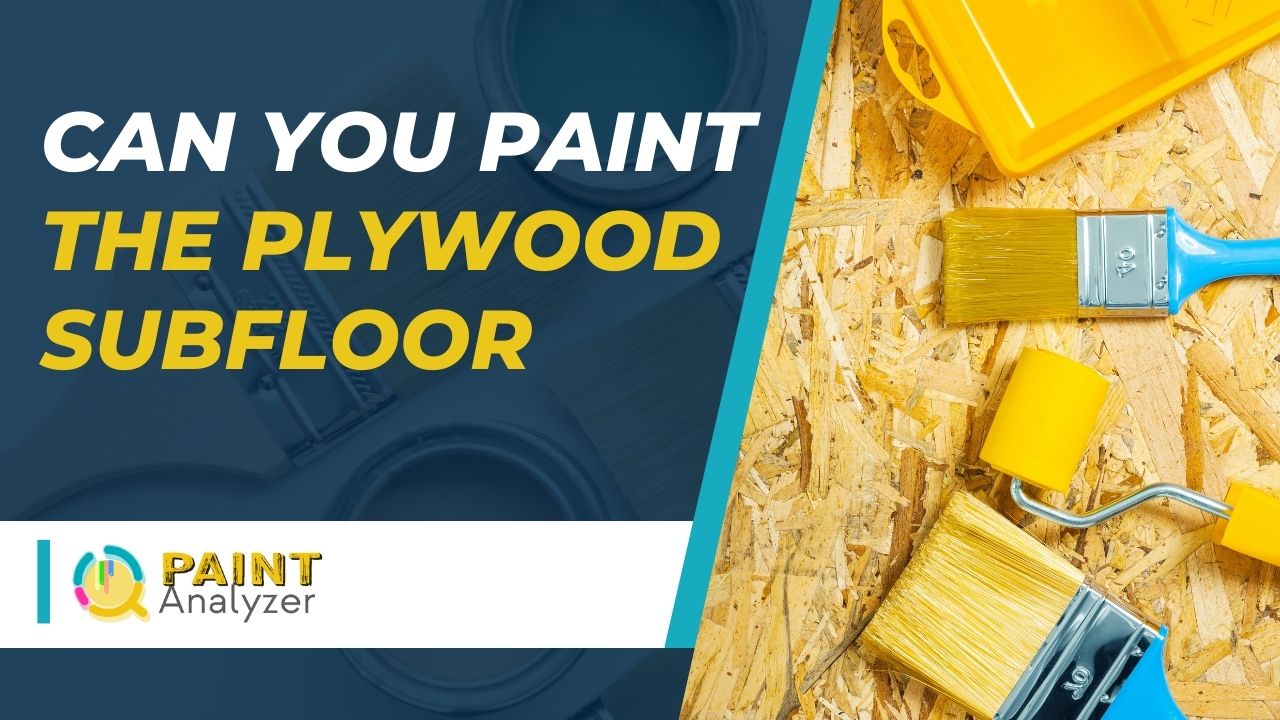When it comes to home renovations, there are endless options for updating and improving the look of your floors. But what if you’re on a tight budget and can’t afford new flooring? Or, what if you’re in the middle of a renovation and need a temporary flooring solution? This is where painting your plywood subfloor comes in.
Yes! Painting the plywood subfloor is a great way to protect it from water damage and wear and tear. But before you start painting, there are a few things you need to know to ensure a successful project.
Let’s explore the pros and cons of painting your plywood subfloor and the steps you need to take to ensure a successful and long-lasting finish.

Painting the Plywood Subfloor- The Pros and Cons
It is possible to paint a plywood subfloor, and it can have both pros and cons depending on your specific situation and needs. Painting a plywood subfloor is a budget-friendly option that can provide a fresh look and help protect the subflooring. Here are some pros and cons to consider:
Pros
- Aesthetics: Painting the subfloor can improve the overall appearance of a space, especially if you’re using the area as a temporary solution before installing a finished flooring material.
- Cost-Effective: Painting the subfloor is generally more affordable than installing other types of flooring, making it a suitable option for temporary or budget-conscious projects.
- Sealing and Protection: Paint can help seal and protect the plywood subfloor from moisture, spills, and minor wear and tear.
- Creativity: You can get creative with colors, patterns, or designs, adding a unique touch to your space.
- Ease of Installation: Painting a subfloor is relatively simple and can be done as a DIY project without specialized tools.
Cons
- Durability: While paint can provide some protection, it might not be as durable or long-lasting as other flooring options. High foot traffic and heavy furniture can cause the paint to wear down over time.
- Preparation: Proper preparation is crucial for a successful paint job. You’ll need to thoroughly clean, sand, and prime the subfloor before painting, which can be time-consuming.
- Maintenance: Painted subfloors may require periodic touch-ups or repainting to maintain appearance and protection.
- Hardness and Comfort: A painted plywood subfloor may not be as comfortable to walk on as other types of flooring, especially if you’re not using rugs or area carpets.
- Resale Value: Painted subfloors might not add as much value to your home as traditional flooring options, which could affect resale potential.
- Moisture Concerns: While paint can help protect against moisture to some extent, it may not provide the same level of moisture resistance as certain flooring materials like tile or vinyl.
- Limited Flooring Options: Once the subfloor is painted, you may be limited in your future flooring choices. Removing paint and prepping the subfloor again for another type of flooring can be a more involved process.
How to Paint the Plywood Subfloor? In detail with step by step guide
Like most people, you probably think painting a plywood subfloor is a difficult task. It is a pretty simple task. But you should follow the proper steps. Here’s a step-by-step guide on how to paint a plywood subfloor:
Step 1: clean the surface
Before painting the plywood subfloor, you must ensure the surface is clean. Otherwise, the paint will not adhere properly, and the finish will not be as good. To clean the surface, sweep it with a broom to remove any loose dirt or debris. Then, use a vacuum cleaner to remove any remaining dirt.
Next, use a damp cloth to wipe down the surface. Make sure to remove any soap residue or other cleaning products that might be on the surface. Use a dry cloth to wipe down the surface one last time. This will ensure that the surface is completely clean and ready for painting.
Step 2: repair any damage
Once the surface is clean, you need to repair any damage that might be present. This includes cracks, holes, or other imperfections.
If there are any small cracks or holes, you can use a putty knife to fill them in with wood filler. Larger cracks or holes might require the use of a patch kit.
Step 3: sand the surface
Now, you need to sand the surface before you start painting. This will create a smooth finish and allow the paint to adhere correctly.
You can use a hand or a power sander to sand the surface. If you use a hand sander, you must use finer grit sandpaper. Once you have sanded the surface, you must use a vacuum cleaner to remove the dust. Otherwise, the dust will get on the paint and ruin the finish.
Step 4: Apply primer
Once the surface is prepared, you need to apply a primer. This will help the paint adhere better and create a better overall finish.
To apply the primer, you can use a paintbrush or a roller. If you use a paintbrush, use a smaller brush for the primer. Once the primer is applied, let it dry completely before moving on to the next step.
Step 5: choose the right paint
There are a few different types of paint that you can use on a plywood subfloor. However, not all types of paint will work well. Latex paint is a good option because it is easy to apply and dries quickly. However, it is not as durable as other types of paint.
Oil-based paint is more durable than latex paint but is also more challenging to apply. It can also take longer to dry. If you are not sure which type of paint to use, you should consult a professional. They can recommend the best type of paint for your needs.
Step 6: Prepare the area
Before you start painting, you need to prepare the area. This includes covering any areas that you do not want to paint. Use painter’s tape to cover areas you do not want to paint. This includes the baseboards, floor moldings, and other areas you do not want to paint.
You should also cover any furniture or other items in the room. You can use a drop cloth or old sheets to protect them from paint.
Step 7: paint the surface
Now, it is time to start painting the plywood subfloor. Begin by painting the edges of the surface first. Then, paint the rest of the surface using long, even strokes.
If you use latex paint, you must apply a second coat. However, if you are using oil-based paint, you might not need a second coat.
Step 8: Seal the Floor
Once the paint is dry, you need to seal the floor. This will protect the paint and make it last longer. There are a few different types of sealer that you can use. However, polyurethane is a good option because it is durable and easy to apply.
To apply the sealer, you can use a brush or a roller. Make sure to apply it evenly and in a well-ventilated area. Once the sealer is dry, remove the painter’s tape and the drop cloths. Then, you can enjoy your newly painted plywood subfloor!
Is painting a wooden surface the same process for both a subfloor and a toilet seat?
Yes, painting a wooden surface is the same process for both a subfloor and a toilet seat. Prepare the surface, sand it down, apply a primer, and then paint the wood with your chosen color. When painting a wooden toilet seat, ensure it’s thoroughly dry before use.
What Kind of Paint is suitable to use on the Subfloor?
When painting subfloors, a few different types of paint can be used. The most common type of paint to use on subfloors is latex-based paint. This type of paint is durable and easy to clean, making it ideal for high-traffic areas.
Another option for painting subfloors is oil-based paint. This type of paint is more durable than latex-based paint, but it can be more challenging to clean.
If you use oil-based paint on your Subfloor, follow the manufacturer’s instructions carefully.
How to prolong the life of your Subfloor?
Your Subfloor is one of the most important parts of your home, so it’s important to take care of it. Here are some tips on how to prolong the life of your Subfloor:
Keep it clean
One of the most important things you can do to prolong the life of your Subfloor is to keep it clean. Vacuum or sweep the Subfloor regularly to remove dirt, dust, and debris. If you have pets, vacuum or sweep up any pet hair that could mat down and cause the Subfloor to deteriorate.
Spot-clean as needed
In addition to regular vacuuming or sweeping, you’ll also need to spot-clean the Subfloor as needed. If you spill something, clean it up right away. If you see any dirt or debris that’s been missed, make sure to clean it up. The more you can keep the Subfloor clean, the longer it will last.
Protect it from moisture
One of the biggest enemies of an exposed subfloor is moisture. Water can cause the Subfloor to swell, warp, and rot. To protect your Subfloor from moisture, make sure to keep any potted plants or water sources away from the Subfloor. In addition, if you live in an area with high humidity, consider using a dehumidifier to help keep the moisture levels down.
Avoid direct sunlight
While some sunlight is good for the Subfloor, too much sunlight can be damaging. Direct sunlight can cause the Subfloor to fade and discolor. If possible, try to keep the Subfloor out of direct sunlight.
Cover it when necessary
There will be times when you can’t avoid exposing the Subfloor to potential damage. If you’re having a party or hosting an event, consider covering the Subfloor with a rug or mat. This will help protect the Subfloor from spills, foot traffic, and other potential damage.
Conclusion
Painting a plywood subfloor is a cost-effective way to update and revamp your flooring. The painting process for a plywood subfloor is pretty straightforward. Just be sure to use a high-quality primer and the best topcoat. Remember to sand between coats if you’re going for a high gloss finish.
If you’re going for stain or paint, you can skip the sanding and just brush or roll on the finish. No matter what you’re using, wear proper safety equipment. And when you’re done, you’ll feel like you have a new floor.
